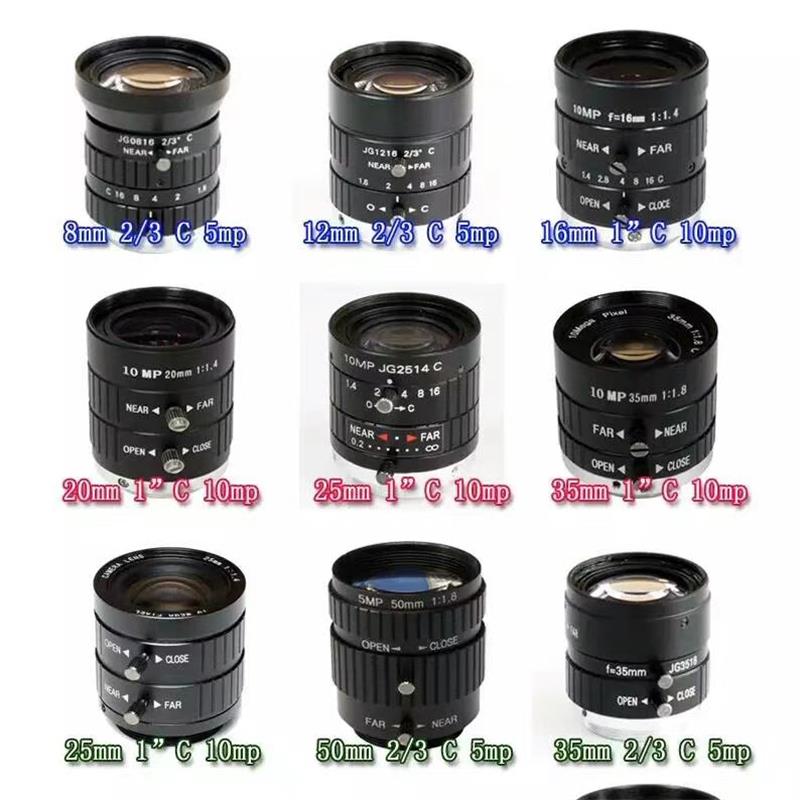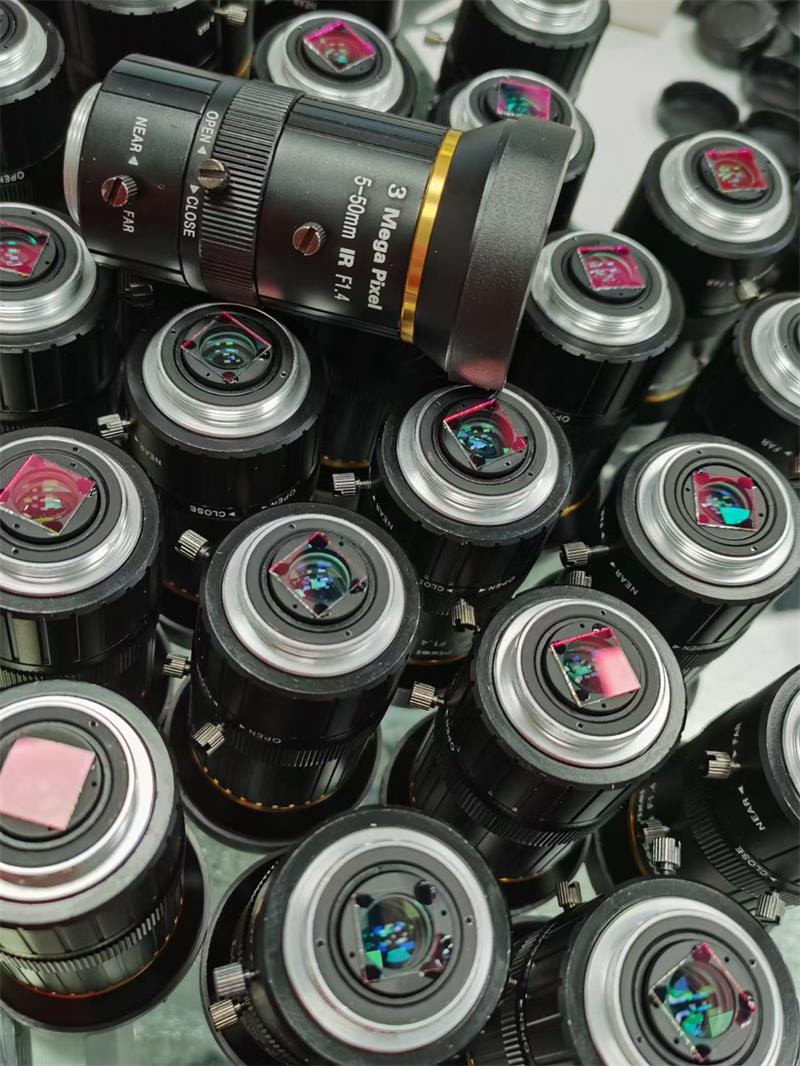Dear Customer,
the following article is useful and valuable for you to knowledge of Industrial Camera Lens and Technical Parameter of industrial lens
1, depth of view:
When an object is focused clearly, all scenery from a distance in front of the object to a distance behind it is also clear. The focal point is quite clear, and the distance from front to back is called depth of view. Depth of field is divided into foreground depth and rear depth of field, and depth of field of field is greater than depth of foreground. The deeper the depth of the scene, the farther away from the focus of the scene can also be clear, and the depth of the scenery, far from the focus of the scene is blurred.
Depth of view refers to the depth range (the distance to the side of the shot object) that makes the lens focus. When the range is large, it is called "depth of view", while when the range is small, it is called "depth of view". Strictly speaking, there is only one focus position, except that the naked eye can feel the image clearly imaging within a certain range, which we call depth of field.
As shown in the figure below, when we shoot this object with tape on the slope that represents height, we compare the situation with the case of the large aperture and the case of the small aperture.
The final depth of view needs to be measured to know. Because in addition to the structure of the lens itself, there are many factors that affect depth of field:
A. The lens itself.
B. The smaller the aperture, the greater the depth of view.
C. The brighter the illumination, the greater the depth of view. (The slower the shutter, the greater the depth of view)
D. The smaller the focal length, the greater the depth of view.
E. The greater the WD working distance, the greater the depth of view.
F. The larger the diameter of a single pixel of the CCD, the greater the depth of view.
2, Focal length:
From the optical principle, the focal length is the distance from the focal point to the center of the lens. For the lens, the focal length has a very important meaning. The focal length is proportional to the image size, the longer the focal length, the larger the image, and the shorter the focal length, the smaller the image. The length of the lens focal length is inversely proportional to the viewing angle, the longer the focal length, the smaller the viewing angle, and the shorter the focal length, the larger the viewing angle. The focal length is inversely proportional to the depth of field, the longer the focal length, the smaller the depth of field, and the shorter the focal length, the greater the depth of field. The length of the focal length is inversely proportional to the sense of perspective. The longer the focal length, the weaker the sense of perspective, and the shorter the focal length, the stronger the sense of perspective. The length of the focal length is inversely proportional to the contrast, the longer the focal length, the smaller the contrast, and the shorter the focal length, the greater the contrast.
The representative lenses of FA (Factory Automation) lenses are those with a focal length of 8 mm /16 mm /25 mm /50 mm.
According to the required field of view and focus distance of the subject you want to shoot, you can find the focus position = WD (working distance).
WD and the size of the field of view are determined by the focal length of the lens and the size of the CCD.
For example: when the focal distance is 16 mm lens and the CCD size is 3.6 mm, if you want to set the field of view to 45 mm, the WD becomes 200 mm.
3. Focus distance
The farther the focusing distance, the deeper the depth of field, the closer the focusing distance, the shallower the depth of field. Therefore, when shooting distant scenes, you should choose a lens with a larger focusing distance, and when shooting close-up scenes, you should use a product with a smaller focusing distance. The lens focusing distance is expressed in cm (centimeters), which can be described as clear at a glance.

4, WD (Work Distance, working distance)
WD represents the distance from the top of the lens to the subject when the subject is in focus. Also called the operating distance.
When it is CCD, the ratio formula is working distance: field of view = focal distance: CCD size is established.
5. Lens FOV:
The angle formed between the center point of the lens and the diagonal ends of the imaging plane is the angle of view of the lens. For the same imaging area, the shorter the focal length of the lens, the larger the angle of view. For a lens, the angle of view mainly refers to the range of angle that it can achieve. When the focal length becomes shorter, the angle of view becomes larger, and a wider range can be shot, but this will affect the sharpness of distant subjects. When the focal length becomes longer, the angle of view becomes smaller, which can make distant objects clear, but the width range that can be photographed becomes narrower.
The field of view refers to the shooting range in the working distance range. Generally speaking, the longer the working distance between the subject and the lens, the wider the field of view (angle of view). In addition, the width of the field of view is determined by the focal length of the lens. Relative to the field of view, the angle of the range that the lens can shoot is called the angle of view or the angle of view. The shorter the focal length of the lens, the larger the angle of view and the wider the field of view. Conversely, the longer the focus distance, the longer the subject can be magnified.
6 Magnification:
Magnification refers to the size of the original imaging area of the subject can be changed by adjusting the lens. Although it is called magnification, some lenses may play a role in zooming out. If the product identification is 1:4, it means that the lens can be magnified up to 4 times.
Number of aperture blades:
The size of the camera lens aperture is adjusted by the change of the blades inside the lens. The number of aperture blades refers to the number of blades used to adjust the aperture in the lens. Generally speaking, the larger the number, the higher the accuracy can be achieved when adjusting the aperture. At present, 6-9 elements are more common.
Lens magnification
The so-called magnification refers to the ratio of the actual size of the test object to the image size of the optical measuring instrument. In the past, we used the concept of optical magnification when observing through the eye of a microscope. However, in recent years, the concept of display magnification has also become popular due to the increasing number of systems that can display observation objects on liquid crystal displays.
7, the resolution of the lens
The resolution of the lens is not only used in image processing, it refers to the minimum interval that can be observed by the lens used in all optical measuring instruments. For lenses with a resolution of 10 m, you can clearly observe striped lines with a width of 10 m and a pitch of 10 m. When the resolution is low, people feel as if the 2 lines overlap. At this point, a higher resolution lens is required.
8, aperture:
An aperture is a device that controls the amount of light that enters the light-sensing surface of the body through the lens, usually within the lens. Expressing the aperture size we use the F-value. Aperture F value - the focal length / lens caliber diameter of the lens, from the above formula can be known to achieve the same aperture F value, the long focal length lens diameter is larger than the short focal length lens calibre. The complete aperture series is as follows: F1, F1.4, F2, F2.8, F4, F5.6, F8, F11, F16, F22, F32, F44, F64. It is worth mentioning here that the smaller the aperture F value, the more light intake in the same unit of time, and the upper level of light intake is just twice that of the next level, for example, the aperture adjusted from F8 to F5.6, the amount of light intake is more than double, we also say that the aperture is one level longer

F value
The F-number (or aperture value) refers to the reference of the brightness of the lens. To be precise, it is the value obtained by dividing the focal length of the lens by the lens diameter (aperture). The "F" of the F value comes from the word focal. In fact, the lens does not let all the light through, some of it will reflect. In addition, when multiple lenses are used to reduce aberrations, the amount of transmitted light will be reduced.
Therefore, the amount of light transmission is more, and the lens that can obtain bright imaging is called "bright". On the contrary, the amount of light transmission is called "dark" than the lens. The relationship between the focal length and the diameter of the lens is one of the elements that can greatly affect the brightness of the lens, that is, the F value. A lens with a smaller value is called a "bright lens", and a larger lens is called a "dark lens". Generally, small cameras will have "F = 2.5" and "1:2.5" marks on the side of the lens, which means the F value is 2.5. In terms of the performance of the camera lens, if the F value reaches about 2.0, it means that the brightness level of the camera is very high.
9. Distorted aberration (distortion)
Distortion aberration (distortion) indicates the state in which the image formed by the lens is distorted.
In fact, there is no perfectly shaped lens. Therefore, although in theory, the direct light will propagate in a straight line after passing through the lens, but in reality, the light will be distorted to the outside or inside after passing through the lens. The former is called "barrel distortion" and the latter is called "pincushion distortion". A parameter of mirror distortion is expressed as a percentage.